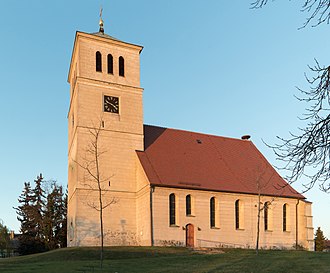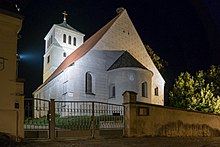St. Marien (Schildau)
The St. Marien Church is a church building in Schildau , part of Belgern-Schildau , in the Saxon district of Northern Saxony . Her first recorded mention was in the year 1198, their church belongs to the parish of Torgau - Delitzsch of the Evangelical Church in Central Germany .
Shape and development
The square church tower with four floors, a pyramid roof and a wall thickness of 1.60 meters on the ground floor is the oldest part of the sacred building . Its entrance was on the east side of the first floor and could only be reached with a ladder, which speaks for its original use as a fortified church . The late Romanesque basilica was added to the tower around 1170 . The wide-span Romanesque arch in the east wall of the tower, which is visible inside the church, also dates from this time.
The church was originally a three-aisled basilica : between the higher central nave and the two lower side aisles, there were four arcade arches on alternating pillars and columns . Above them, four windows were installed in the upper cladding area of the central nave below the flat wooden ceiling, which let in daylight.
The structure is a quarry stone building with plaster ashlars , the apse has smooth plaster , and the buttresses on the southeast corner and the basket-arched windows are also remarkable .
Extensions and alterations were made in the 13th century, in the second half of the 15th century, in the first half of the 17th century (heightening and lengthening of the side aisle walls), at the end of the 17th / beginning of the 18th century, at the end of the 18th century And in the 19th century. From 1783 to 1784 the roof structure was raised and from 1829 to 1833 there was restoration work. The following architectural styles can be found: Romanesque , Gothic , Baroque and Classicism .
Interior design
Conversions in the 15th century, presumably to remove the damage caused by the Hussites , created the church hall in its present-day appearance: the columns were removed, the upper clad windows walled up and a ribbed vault inserted. A pseudo-basilica was created . One of the top windows above the ribbed vault has been exposed for inspection. A wooden frame is visible there, which was once used to attach the parchment skin used as "window glass" . An old columns remaining bears in the choir square the Renaissance - baptismal font .
The side aisles are flat-roofed (Romanesque fighter plates ), a gallery is attached to the west wall and the side aisles.
The sacristy in the north wall of the choir square and the winged altar date from the 15th century. The front of the altar shows carved depictions of the story of Jesus and the life of Mary, on the back the saints St. Martin, St. Catherine, St. Ursula and St. Maria Magdalena are depicted in paintings .
organ
The organ was created by Matthias Vogler from Naumburg (Saale) in 1805. It has 20 stops on two manuals and a pedal . The instrument was rebuilt in 1939 and restored in 2003 by the Central German organ builder A. Voigt .
Peal
The bells of the church belonged to the Bronze - Church bells ensembles from the period before the First World War . In both the First and Second World War , historical bells had to be handed in due to the state-ordered “ metal donation ” campaign, so that only the bell from 1741 remained.
The ringing consists of the following three bells:
- Bell 1 with root e ′, replacement bell, year unknown
- Bell 2 with the keynote g ′, historical bell from 1741
- Bell 3 with root h ′, replacement bell, year unknown
The three bells hung on cranked steel yokes until problems arose in 2009. Cracks were also discovered on the yoke of the oldest bell. The old yokes were then removed and replaced by wooden yokes.
Varia
- In the sacristy, fitted into the north apse wall, there is a wooden jewel - a cabinet made of long-fiber sawn coniferous wood , possibly the only original preserved from the 15th century in the Free State of Saxony.
- The church box with five locks embedded in the floor of the sacristy and the medieval piscina are rarities.
- In the historic cemetery surrounding the church, which was in use until 1913, there is a mulberry tree that is known to have been planted in 1518. However, despite the opinion expressed in and around Schildau, it is not necessarily the oldest mulberry tree in Germany; the so-called millennial mulberry tree in the garden of the Benedictine abbey Brauweiler is probably less than a thousand years old, but it could be older than the one in Schildau.
literature
- Georg Dehio: Handbook of the German art monuments , Saxony II, administrative districts Leipzig and Chemnitz. Deutscher Kunstverlag, Munich Berlin 1998, ISBN 978-3-422-03048-0 .
- Lutz Heydick: Northern Saxony district historical guide. Sax-Verlag, Beucha Markkleeberg 2016, ISBN 978-3-86729-171-2 .
- The Vogler organ in the town church of St. Marien zu Schildau. In: Felix Friedrich; Vitus Froesch: Organs in Saxony - A travel guide . Ed .: Society of Organ Friends. Kamprad, Altenburg 2012, ISBN 978-3-930550-89-0 , p. 42 .
Web links
- Stadtkirche Sankt Marien , website of the city administration of Belgern-Schildau
- Ev. City Church St. Marien Schildau (near Leipzig) , www.architektur-blicklicht.de
- Stadtkirche St. Marien , Evangelical Church in Central Germany
- Schildau , church district Torgau-Delitzsch
- Schildau in the Digital Historical Directory of Saxony
Individual evidence
- ^ Schildau Gneisenaustadt | Schildau - Ev.-Luth. Church , Association of German Organ Builders, accessed on February 27, 2020.
- ↑ Restoration of the church organ in Schildau. Sparkassenstiftung for the Torgau-Oschatz region, accessed on February 27, 2020.
- ^ The Vogler organ in the town church of St. Marien zu Schildau. In: Felix Friedrich; Vitus Froesch: Organs in Saxony - A travel guide . Ed .: Society of Organ Friends. Kamprad, Altenburg 2012, ISBN 978-3-930550-89-0 , p. 42 .
- ↑ The bells of the Schildau town church , video on Youtube, accessed on February 27, 2020.
- ↑ Kirchen am Weg , www.lutherweg-sachsen.de, accessed on February 27, 2020.
- ↑ entry to mulberry tree in Abbey Park Brauweiler (natural monument) in the database " KuLaDig " of the Regional Association of the Rhineland , accessed on February 27 2020th
Coordinates: 51 ° 27 ′ 14.2 " N , 12 ° 55 ′ 47" E




